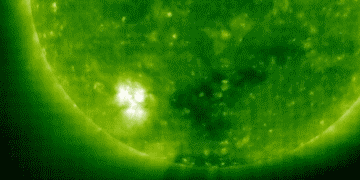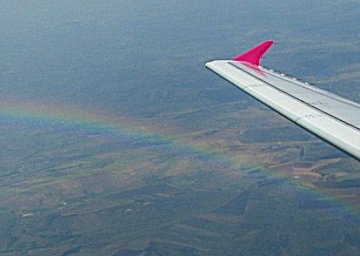| WATER ON THE MOON: How much water can you squeeze out of a ton of moondust? About 32 ounces, according to NASA. In a press conference yesterday, the space agency announced that three spacecraft have found signs of water molecules mixed in lunar topsoil. This bodes well for future lunar explorers who could use H2O to drink--or O2 to breathe--or H2 for rocket fuel to get back to Earth! Science@NASA has the full story. SOLAR FLARE: New-cycle sunspot 1026 is crackling with magnetic activity, and this morning it produced a C-class solar flare. The Solar and Heliospheric Observatory's (SOHO's) extreme UV telescope recorded the action around 0100 UT on Sept. 25th: 
If you thought that flare seemed small, you were right. It was about 100-times too weak too affect Earth. During Solar Maximum, such a minor eruption would probably go unnoticed and certainly unmentioned. But during the deepest solar minimum in almost 100 years, it's a big event. A C-flare! The blast raised no radio blackouts or radiation storms--only the hopes of solar observers for something more flamboyant. Stay tuned. sunspot photos: from Pete Lawrence of Selsey, West Sussex, UK; from Andy Yeung of Hong Kong; from John C McConnell of Maghaberry Northern Ireland.; from Trevor Little on the south coast of England; from Francisco A. Rodriguez of Cabreja Mountain Observatory, Canary Islands; from Richard Best of Sussex, England; from Fabio Mariuzza of Biauzzo, Italy; from Jörgen Blom of Stockholm, Sweden; from Pavol Rapavy of Observatory Rimavska Sobota, Slovakia DRACULA'S RAINBOW: Earlier this month, Dóra Nehéz was sitting in the window seat of an airplane that had just taken off from Tirgu Mures, Transylvania. "We were about 1 km high when I looked out the window and saw a rainbow underneath the airplane," says Nehéz. "It lasted about a minute--long enough for me to grab my camera and take a few pictures." 
Rainbows are usually seen by looking up, but not this time. Atmospheric optics expert Les Cowley offers a grave explanation for the unusual phenomenon: "Unlike a certain Transylvanian resident, rainbows prefer sunlight and their reflections really are visible in mirrors!" he says. "Because rainbows are caused by sunlight reflecting from raindrops, rainbows and the sun are always located on the opposite sides of the sky. In this case, a high sun combined with fortuitous raindrops below the airplane to produce a very low 'bow." "Look for such rainbows when coming into land on a showery day," he suggests. "It's something to sink your teeth into."
Sept. 2009 Aurora Gallery
[previous Septembers: 2008, 2007, 2006, 2005, 2004, 2002, 2001]
Explore the Sunspot Cycle | 
